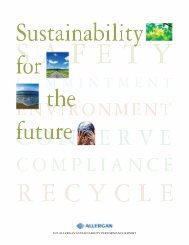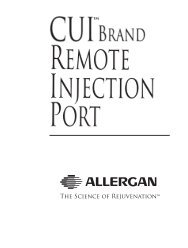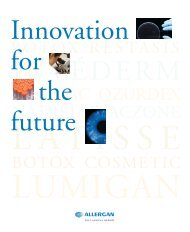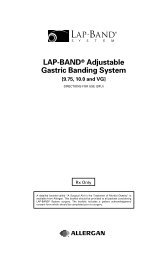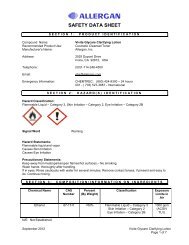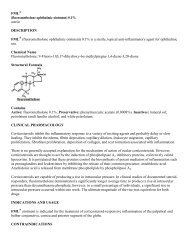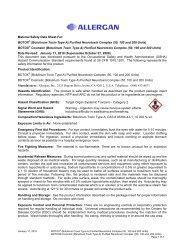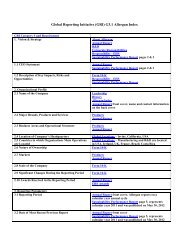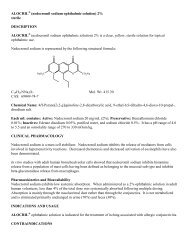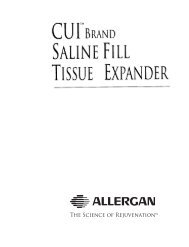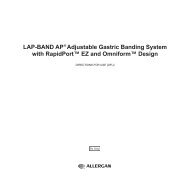Timolol - Allergan
Timolol - Allergan
Timolol - Allergan
Create successful ePaper yourself
Turn your PDF publications into a flip-book with our unique Google optimized e-Paper software.
PACIFIC PHARMA L.P.<br />
MATERIAL SAFETY DATA SHEET<br />
National Fire Protection Association (NFPA) Rating: Health: 1 Flammability: 0 Reactivity: 0 Special: 0<br />
TELEPHONE CONTACTS:<br />
Product Technical and Medical Information: (800) 433-8871<br />
Transportation Emergency 24-Hour Response (CHEMTREC): (800) 424-9300<br />
SECTION 1:<br />
PRODUCT IDENTIFICATION<br />
Compound Name: <strong>Timolol</strong> Maleate Ophthalmic Solution, 0.25% and 0.5%<br />
Chemical Class:<br />
Manufacturer's Name:<br />
Address:<br />
Beta-Adrenergic Receptor Blocking Agent<br />
Pacific Pharma L.P.<br />
2525 Dupont Drive<br />
Irvine, CA 92612<br />
Preparation Date: June 20, 2001 (Supersedes July 16, 1997)<br />
SECTION 2:<br />
COMPOSITION/HAZARDOUS INGREDIENTS<br />
Chemical Name CAS Number Percent<br />
Exposure Limits in Air<br />
(By Weight OSHA PEL ACGIH TLV<br />
<strong>Timolol</strong> Maleate, USP 26921-17-5 0.25 and 0.50 N/E N/E<br />
Sodium Phosphate dibasic,<br />
heptahydrate<br />
7782-85-6 2.35 N/E N/E<br />
SECTION 3: H A Z ARDS IDENTIFICATION<br />
EMERGENCY OVERVIEW: As with other beta-adrenergic blocking agents, inadvertent overdose<br />
or overexposure to <strong>Timolol</strong> Maleate Ophthalmic Solution, 0.25% and 0.5% may cause<br />
dizziness, headache, shortness of breath, bronchospasm, heart rhythm abnormalities, or cardiac<br />
arrest. If symptoms develop, seek medical attention immediately.<br />
Potential Health Effects:<br />
Eye Contact:<br />
Skin Contact:<br />
Inhalation:<br />
Contact with the eyes may result in mild to moderate transient irritation<br />
(burning or stinging) in sensitive individuals. Avoid unintentional<br />
contact with the eyes. Overdose or overexposure may result in<br />
symptoms associated with beta-adrenergic blocking agents. These<br />
may include: headache; dizziness; fatigue; chest pain; nausea;<br />
breathing difficulty and cardiac abnormalities.<br />
Topical administration or exposure may result in systemic absorption,<br />
producing symptoms as described above.<br />
The product is non-volatile and inhalation is not likely to occur.<br />
June 20, 2001 <strong>Timolol</strong> Maleate Ophthalmic Solution, 0.25% and 0.5%<br />
Page 1 of 5
Ingestion: May produce stomach upset and nausea. May be absorbed<br />
systemically, resulting in symptoms described above. Significant<br />
overexposure may result in heart block or cardiac arrest.<br />
Chronic Effects: Chronic exposure to <strong>Timolol</strong> Maleate Ophthalmic Solution, 0.25%<br />
and 0.5% may produce symptoms similar to those described above.<br />
Persons chronically exposed to this material should be periodically<br />
monitored for pulmonary abnormalities as well as cardiac irregularities.<br />
No ingredient in this product is regulated or listed as a carcinogen by<br />
OSHA, IARC, or NTP.<br />
Conditions Which May Be<br />
Aggravated by Exposure:<br />
Conditions which may be aggravated by exposure include<br />
bronchial asthma, obstructive pulmonary disease, heart rhythm<br />
abnormalities, heart disease, or cerebrovascular insufficiencies.<br />
SECTION 4:<br />
FIRST AID MEASURES<br />
Eye Contact:<br />
Skin Contact:<br />
If irritation persists, flush eyes with plenty of water for at least 15 minutes.<br />
Obtain medical attention if irritation persists or if other symptoms develop.<br />
Wash skin thoroughly with soap and water. If irritation or other symptoms<br />
develop, consult a physician.<br />
Wash contaminated clothing before reuse.<br />
Inhalation:<br />
Ingestion:<br />
Inhalation is not likely to occur. If symptoms occur, move to<br />
fresh air and obtain medical attention. Treat symptomatically.<br />
Seek medical attention immediately. Treatment of an oral overdose<br />
includes supportive and symptomatic therapy. Patients should be<br />
monitored for signs or symptoms associated with exposure to betaadrenergic<br />
blocking agents including breathing abnormalities, heart<br />
irregularities or cardiopulmonary insufficiencies.<br />
SECTION 5:<br />
FIRE FIGHTING MEASURES<br />
Flash Point and Method:<br />
Flammable Limits:<br />
Autoignition Temperature:<br />
Fire-Extinguishing Materials:<br />
Firefighting Procedures:<br />
Unusual Fire and Explosion<br />
Hazards:<br />
Greater than 200°F (Seta Flash Cup)<br />
Not applicable<br />
No data for this product<br />
Material is non-flammable. Use extinguishing media<br />
suitable for materials supporting combustion such as water fog, CO 2 ,<br />
foam or dry chemical.<br />
Use self-contained breathing apparatus in enclosed or confined<br />
spaces or as otherwise needed.<br />
None known<br />
June 20, 2001 <strong>Timolol</strong> Maleate Ophthalmic Solution, 0.25% and 0.5%<br />
Page 2 of 5
SECTION 6:<br />
ACCIDENTAL RELEASE MEASURES<br />
Wipe up spilled liquid with absorbent material and wash area with water. If large quantities<br />
are spilled, flush spill area with water.<br />
SECTION 7: HANDLING AND STORAGE<br />
Handling:<br />
Storage:<br />
Avoid contact with skin surfaces. Wash thoroughly after handling. Observe all precautions<br />
contained on product label and package insert.<br />
Store in a cool, dry location out of direct sunlight. Keep container closed when not in use.<br />
SECTION 8:<br />
EXPOSURE CONTROLS AND PERSONAL PROTECTION<br />
Engineering Controls:<br />
Respiratory Protection:<br />
Eye Protection:<br />
Protective Clothing:<br />
Hygienic Work Practices:<br />
SECTION 9:<br />
Vapor Density (Air = 1):<br />
None necessary for normal product handling.<br />
None necessary for normal product handling.<br />
None required for normal product handling. If responding to<br />
a spill situation, use safety glasses with side shields.<br />
None required for normal product handling. Use latex or chemical<br />
resistant gloves and other protective clothing as necessary to avoid<br />
liquid contact during spill response.<br />
Wash hands thoroughly after handling. If working with large quantities<br />
of liquid (such as spill clean-up), use latex or chemical resistant gloves<br />
and appropriate eye protection. No eating, drinking or smoking in<br />
area.<br />
PHYSICAL AND CHEMICAL PROPERTIES<br />
No data for this product<br />
Boiling Point: >100° C (>212° F)<br />
Solubility in Water:<br />
Soluble<br />
Specific Gravity: Approximately 1.0<br />
pH: 6.7 - 7.1<br />
Vapor Pressure (mm Hg at 20° C):<br />
Appearance and Odor:<br />
No data for this product<br />
Clear liquid with slight odor<br />
SECTION 10:<br />
STABILITY AND REACTIVITY<br />
General:<br />
This product is stable and hazardous polymerization will not occur.<br />
Incompatible Materials Store away from oxidizers and heat. Store below 25 o C.<br />
and Conditions to Avoid:<br />
Hazardous Decomposition:<br />
None known<br />
June 20, 2001 <strong>Timolol</strong> Maleate Ophthalmic Solution, 0.25% and 0.5%<br />
Page 3 of 5
SECTION 11:<br />
TOXICOLOGICAL INFORMATION<br />
Oral:<br />
Ocular:<br />
Reproduction:<br />
Mutagenicity:<br />
Carcinogenicity:<br />
The oral LD 50<br />
for <strong>Timolol</strong> Maleate Ophthalmic Solution, 0.25% and 0.5% is<br />
reported to be 1028 mg/kg in rats and 1137 mg/kg in mice. In other studies,<br />
significant lethality was observed in female rats and female mice after a single<br />
dose of 900 and 1190 mg/kg of timolol, respectively. No details of the toxic effects<br />
were reported. A thirty year old human female who ingested 650 mg of <strong>Timolol</strong><br />
Maleate Ophthalmic Solution, 0.25% and 0.5% tablets experienced second and<br />
third degree heart block. After recovery she subsequently developed irregular<br />
heartbeat, hypertension, dizziness, tinnitus, faintness, increased pulse rate and<br />
borderline first degree heart block.<br />
No studies of ophthalmic toxicity in rodents have been reported. The maximum<br />
recommended human ophthalmic dose of <strong>Timolol</strong> Maleate Ophthalmic Solution,<br />
0.25% and 0.5% is equivalent to 7.14 micrograms (µg)/kilogram/day. There are<br />
reports of patients developing ocular symptoms (burning, conjunctivitis, discharge<br />
and stinging) and systemic symptoms (headache, dizziness, bradycardia) after<br />
administration of the therapeutic dose. Persons with chronic obstructive<br />
pulmonary disease (e.g. chronic bronchitis, emphysema), bronchospastic disease,<br />
bronchial asthma, or history of cardiac disease should not be exposed to <strong>Timolol</strong><br />
Maleate Ophthalmic Solution, 0.25% and 0.5%.<br />
No teratogenic or reproductive effects were observed in mice, rats and rabbits at<br />
doses up to 50 mg/kg/day (7,000 times the maximum recommended human<br />
ophthalmic dose). Reproduction and fertility studies in rats demonstrated no<br />
adverse effect on male or female fertility at doses up to 21,000 times the systemic<br />
exposure following the maximum recommended human ophthalmic dose.<br />
<strong>Timolol</strong> Maleate Ophthalmic Solution, 0.25% and 0.5% was negative when<br />
tested in vivo (mouse) in the micronucleus test and cytogenetic assay (doses up to<br />
800 mg/kg) and in vitro in a neoplastic cell transformation assay (up to 100 µg/mL).<br />
Ames testing was negative in three of the four strains tested. In the fourth strain<br />
tested (TA100), no consistent dose response relationship was seen, nor did the<br />
ratio of test to control revertants reach the criteria for positive Ames test, and<br />
therefore the overall result was considered negative.<br />
In a lifetime oral study in mice, an increased incidence of benign and malignant<br />
pulmonary tumors, benign uterine polyps and mammary adenocarcinomas in<br />
female mice was observed at a dose of 500 mg/kg/day (71,000 times the systemic<br />
exposure following the maximum recommended human ophthalmic dose). No<br />
tumors were observed at doses levels of 5 or 50 mg/kg/day (700 and 7,000 times<br />
the recommended human dose).<br />
SECTION 12:<br />
ECOLOGICAL INFORMATION<br />
No ecological information is available for the product.<br />
SECTION 13:<br />
DISPOSAL CONSIDERATIONS<br />
For small quantities of <strong>Timolol</strong> Maleate Ophthalmic Solution, 0.25% and 0.5%, discard as<br />
ordinary trash. For large quantities, contact <strong>Allergan</strong> for information on disposal options.<br />
SECTION 14:<br />
TRANSPORT INFORMATION<br />
June 20, 2001 <strong>Timolol</strong> Maleate Ophthalmic Solution, 0.25% and 0.5%<br />
Page 4 of 5
Not a hazardous material for DOT, IATA, IMO or TDG shipment.<br />
SECTION 15:<br />
REGULATORY INFORMATION<br />
TSCA (Toxic Substances Control Act):<br />
Components of this product are listed on the TSCA Inventory.<br />
CERCLA (Comprehensive Environmental Response, Compensation, and Liability Act:<br />
This product contains no components subject to reporting or notification requirements.<br />
SARA Title III (Superfund Amendments and Reauthorization Act):<br />
311/312 Hazard Categories: Immediate Health, Chronic Health<br />
313 Reportable Ingredients: None<br />
WHMIS (Workplace Hazardous Materials Information System - Canada):<br />
Not Regulated (Product is regulated by the Food and Drugs Act)<br />
SECTION 16:<br />
OTHER INFORMATION<br />
The preceding information is based on available data and is believed to be correct. However, no<br />
warranty is expressed or to be implied regarding the accuracy of this information, the results to be<br />
obtained from the use thereof or the hazards connected with the use of the material. Since the<br />
information contained herein may be applied under conditions beyond our control and with which we may<br />
be unfamiliar, <strong>Allergan</strong> does not assume any responsibility for the results of its use. This information is<br />
furnished upon the condition that the persons receiving it shall make their own determinations of the<br />
effects, properties, and protections which pertain to their particular conditions.<br />
June 20, 2001 <strong>Timolol</strong> Maleate Ophthalmic Solution, 0.25% and 0.5%<br />
Page 5 of 5



